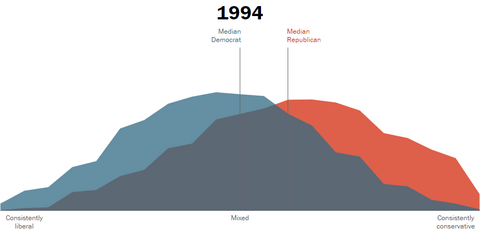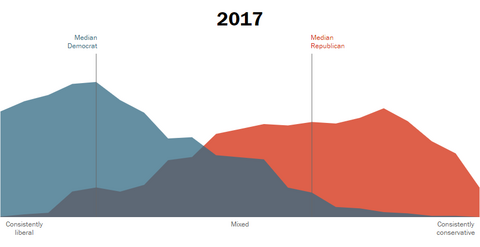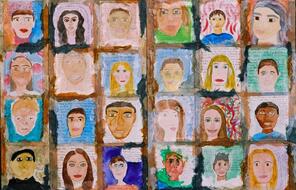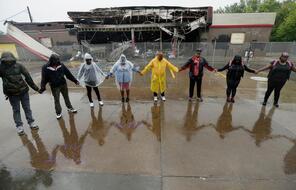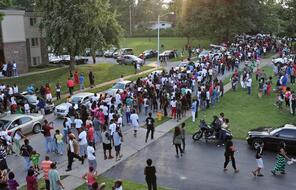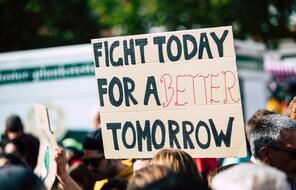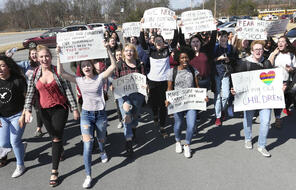Political Polarization in the United States
Subject
- Civics & Citizenship
- History
- Social Studies
Language
English — USUpdated
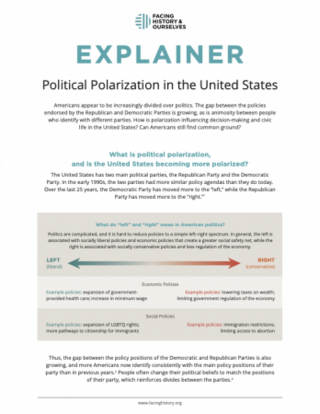
Explainer: Political Polarization in the United States
Download a PDF of this resource for free
What is political polarization, and is the United States becoming more polarized?
The United States has two main political parties, the Republican Party and the Democratic Party. In the early 1990s, the two parties had more similar policy agendas than they do today. Over the last 25 years, the Democratic Party has moved more to the “left,” while the Republican Party has moved more to the “right.” 1
What do “left” and “right” mean in American politics?
Politics are complicated, and it is hard to reduce policies to a simple left–right spectrum. In general, the left is associated with socially liberal policies and economic policies that create a greater social safety net, while the right is associated with socially conservative policies and less regulation of the economy.
LEFT (liberal)
- Example economic policies: expansion of government-provided health care; increase in minimum wage
- Example social policies: expansion of LGBTQIA+ rights; more pathways to citizenship for immigrants
RIGHT (conservative)
- Example economic policies: lowering taxes on wealth; limiting government regulation of the economy
- Example social policies: immigration restrictions; limiting access to abortion
Thus, the gap between the policy positions of the Democratic and Republican Parties is also growing, and more Americans now identify consistently with the main policy positions of their party than in previous years. 2 People often change their political beliefs to match the positions of their party, which reinforces divides between the parties. 3
- 1Geoffrey Layman, Thomas Carsey, and Juliana Menasce Horowitz, “Party Polarization in American Politics: Characteristics, Causes, and Consequences,” The Annual Review of Political Science 9 (2006), 83-110. “Political Polarization in the American Public,” Pew Research Center, June 12, 2014.
- 2Geoffrey Layman, Thomas Carsey, and Juliana Menasce Horowitz, “Party Polarization in American Politics: Characteristics, Causes, and Consequences,” The Annual Review of Political Science 9 (2006), 83-110.
- 3Geoffrey Layman, Thomas Carsey, and Juliana Menasce Horowitz, “Party Polarization in American Politics: Characteristics, Causes, and Consequences,” The Annual Review of Political Science 9 (2006), 83-110.
Americans also tend to have greater feelings of dislike toward members of the other political party than they have had in previous years. 1
- 1Shanto Iyegar, Yphtach Lelkes, Matthew Levendusky, Neil Malhotra, and Sean Westwood (2019). The Origins and Consequences of Affective Polarization in the United States. The Annual Review of Political Science (22). 129-146.
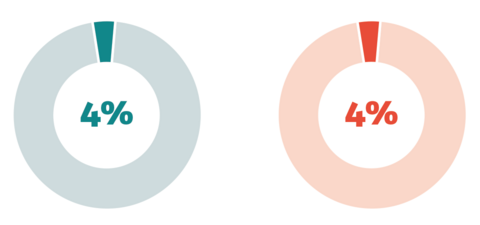
In 1960, 4% of Republicans and 4% of Democrats said they would be displeased if their son or daughter married someone of the opposite party. 1
- 1Maxine Najle and Robert P. Jones, “American Democracy in Crisis: The Fate of Pluralism in a Divided Nation,” PRRI, February 19, 2019.
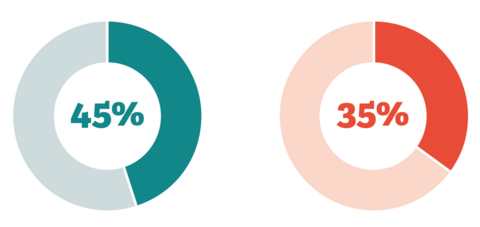
In 2019, 45% of Democrats said they would be unhappy if their child married a Republican and 35% of Republicans say they would be unhappy if their child married a Democrat. 1
ASK YOURSELF: What does political polarization look, sound, and feel like where you live?
What causes polarization?
Polarization is complex, and scholars are still debating the exact factors that contribute to it. This section highlights four of the many factors that are likely contributing to polarization’s rise.
- Political Activism: Political activists in each party tend to push for policies that are further to the left (in the Democratic Party) and further to the right (in the Republican Party). Some scholars believe that the increased influence of political activists has widened the gap between the two parties’ platforms. 2
- Election Policies: Recent policy changes have given political activists more power to influence which candidates get picked to run for office. For example, campaign finance reforms have made it easier for political activists to give large amounts of money to the candidate they support. Also, more districts are gerrymandered , which can lead to districts that are overwhelmingly populated by members of the same party. Gerrymandered districts often elect candidates who support policies that appeal more to the party base than to the center of the political spectrum. Primary elections can push political parties more toward the poles as well, since candidates often must appeal to activists within their political party in order to win a primary.
- In-Group Bias: Psychological factors also play a vital role in reinforcing partisanship. While we may like to think that people form their political opinions based on a rational evaluation of different policies, research shows that cognitive biases, such as in-group bias, drive people to change their political opinions to match those of their group.
Anytime we join a group, we start to develop positive feelings toward other group members and negative or distrustful feelings toward non-members. 3 In the American two-party system, people often have negative associations with members of the other political party. These negative feelings can make it difficult for people to have productive conversations about policy across the political divide. Once people are members of a political party, they often switch their political opinions to match the positions of their chosen party. As a result, as political parties become more polarized, so do the average voters. 4 - Media Bubbles: Many Americans are exposed to partisan news in their social media feeds and often have very few social media friends on the other end of the political spectrum. 5 Online platforms, such as YouTube, use algorithms to expose viewers to increasingly extreme content, which can lead them to fringe political views without their realizing it. 6 Spending time in a political echo-chamber can make it easier for negative feelings toward members of the other political party to develop.
What are the consequences of polarization?
Polarization is not all bad. The two main political parties in the United States are now more distinct than in previous decades, which gives voters more meaningful choices. 7 However, as political parties move toward the poles and people increasingly distrust members of the other political party, it has become difficult for politicians to agree on a way forward. Congress is more likely to gridlock and find it difficult to pass legislation, while campaigns and partisan media can become more divisive.
ASK YOURSELF: How do you think polarization might influence how Americans respond to current issues?
What are the limits of polarization?
Despite growing polarization, Americans are less likely to express negative feelings toward someone of the other political party if they are told that the other person does not care very much about politics, or if they are asked to focus on other aspects of their identities, like their shared identity as Americans or fans of the same sports team.
In addition, many policies have bipartisan support, or support from members of both the Republican and Democratic Parties. For example:
- 1Maxine Najle and Robert P. Jones, “American Democracy in Crisis: The Fate of Pluralism in a Divided Nation,” PRRI, February 19, 2019.
- 2Geoffrey Layman, Thomas Carsey, and Juliana Menasce Horowitz, “Party Polarization in American Politics: Characteristics, Causes, and Consequences,” The Annual Review of Political Science 9 (2006), 83-110.
- gerrymanderedgerrymandered : Gerrymandering is the practice of drawing the boundaries of a legislative district to give one political party an advantage over the other.
- 3Shanto Iyegar, Yphtach Lelkes, Matthew Levendusky, Neil Malhotra, and Sean Westwood (2019). The Origins and Consequences of Affective Polarization in the United States. The Annual Review of Political Science (22). 129-146.
- 4Geoffrey Layman, Thomas Carsey, and Juliana Menasce Horowitz, “Party Polarization in American Politics: Characteristics, Causes, and Consequences,” The Annual Review of Political Science 9 (2006), 83-110.
- 5Shanto Iyegar, Yphtach Lelkes, Matthew Levendusky, Neil Malhotra, and Sean Westwood (2019). The Origins and Consequences of Affective Polarization in the United States. The Annual Review of Political Science (22). 129-146.
- 6Kevin Roose, “The Making of a YouTube Radical,” New York Times, June 8, 2019.
- 7Geoffrey Layman, Thomas Carsey, and Juliana Menasce Horowitz, “Party Polarization in American Politics: Characteristics, Causes, and Consequences,” The Annual Review of Political Science 9 (2006), 83-110.
of Americans are in favor of encouraging highly skilled immigrants to come to the United States.
Phillip Connor and Neil G. Ruiz, “Majority of U.S. Public Supports High-Skilled Immigration,” Pew Research Center, January 22, 2019.
of voters support spending $1.3 trillion to weatherize homes, making them more energy efficient.
Robinson Meyer, “Five Radical Climate Policies That Most Americans Actually Like,” The Atlantic, October 7, 2019.
of Americans are in favor of requiring background checks on people who buy guns through private sales or gun shows.
“Gun Policy Remains Divisive, But Several Proposals Still Draw Bipartisan Support,” Pew Research Center, October 18, 2018.
What can I do about political polarization?
Reforming the policies that govern elections and governance can help decrease political polarization, but there are also things that individuals can do:
- Focus on issues rather than parties: Decide what policies you want to pass, instead of focusing only on which political party you want to win the election. Try getting involved in local politics, where issues often matter more than political parties.
- Break out of your media bubble: Try to follow a variety of news sources that examine issues from different political angles. You can use AllSides to find out more about the political leanings of different news outlets.
- Learn to listen: Try to understand the perspectives of people on the other side of the political spectrum and listen to other points of view before judging. Read the Greater Good Magazine article Five Ways to Have Better Conversations Across Difference for advice on how to have a productive discussion with people who have different perspectives or experiences.
ASK YOURSELF: What other individual or policy changes do you think could help to decrease the negative effects of polarization?
How to Cite This Explainer
Facing History & Ourselves, “Political Polarization in the United States”, last updated October 22, 2019.

